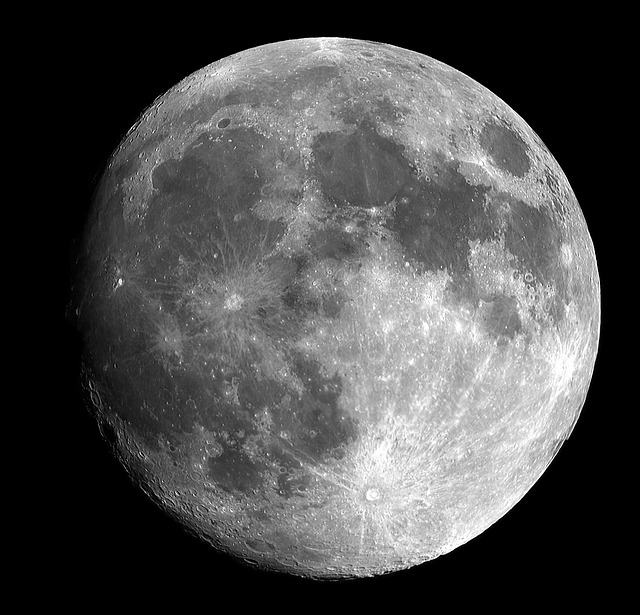By Tim Lambert
Observing the Moon
The Moon has always been visible, of course, but the Ancient Greeks were the first people to begin to understand it. About 450 BC, an Ancient Greek called Anaxagoras realized that the Moon does not shine with its own light. Instead, its light is reflected from the Sun.
Another Ancient Greek named Aristarchus (c 310-230 BC) measured the relative distances of the Sun and Moon. He realized the Sun is much further away than the Moon. He also attempted to measure the size of the Moon relative to the Earth, but overestimated its size. He thought it was about 1/2 the size of the Earth, when in fact it was about 1/4. About 150 BC, a Greek called Seleucus of Seleucia realized the Moon causes the tides on Earth.
However, no further information about the Moon could be gained till the telescope was invented. Galileo turned his telescope on the Moon. The ancient Greeks believed that the Moon was smooth. Looking through a telescope, Galileo could see that the Moon’s surface is rough, with mountains and craters.
Following the invention of the telescope, people began to make charts of the Moon. In 1647, a Polish astronomer called Johannes Hevelius published an ‘atlas’ of the Moon called Selenographia. (Selene was a Greek goddess of the Moon).
In 1651, Giovanni Riccioli published a book called New Almagest in which he gave names to the ‘seas’ and other features on the Moon.
The first photo of the Moon was taken in 1839 by Louis Daguerre.
The Moon in Science Fiction
In the 2nd century, a man named Lucian wrote a book about a ship that is lifted on a waterspout to the Moon. The great astronomer Johannes Kepler wrote a story about a trip to the Moon called The Dream, which was published after his death, in 1634. Later in the 17th century, Cyrano de Bergerac wrote a story called Voyage to the Moon.
The first realistic story about traveling to the Moon was a book called From the Earth to the Moon by Jules Verne, published in 1865. It was followed by a book called The First Men in the Moon by H.G. Wells. In the late 20th century, science fiction novels about human beings colonizing the Moon became common.
In 1835, a newspaper called the New York Sun claimed that by using a new powerful telescope, people could see plants and animals on the Moon. They could also see ‘people’ who were half man and half bat.
Many films have been made about the Moon. Among them was Moon Zero Two in 1969. In the TV program Space 1999, the Moon was blasted out of its orbit and wanders through space.
Nobody knows why we say ‘over the Moon’, but in 1718 a playwright called Charles Molloy wrote: ‘Tis he! I know him now: I shall jump over the Moon for joy!’ The nursery rhyme with the words ‘the cow jumped over the Moon’ was first published in 1765.
Exploring the Moon
In January 1959, the Russians launched the first space probe, Luna I (Luna was a Roman Moon goddess). It flew within 5,000 miles of the Moon. Also in 1959, Luna 2 crashed onto the Moon. In October 1959, Luna 3 took the first photos of the Dark Side of the Moon. Then, in 1964, Ranger 7 sent back detailed photos of the Moon. Finally, in 1966, Luna 9 achieved the first soft landing on the Moon. It was the first of several Soviet probes to land on the Moon.
Meanwhile, in 1961, President Kennedy proposed to land a man on the Moon before the decade was out. The first step was Apollo 8, which was launched on 21 December 1968 carrying 3 astronauts. The spacecraft orbited the Moon 10 times and returned safely to Earth. Further preparations followed with Apollo 9 and Apollo 10 in 1969.
There were 3 astronauts on the Apollo 11 mission: Neil Armstrong, Edwin (Buzz) Aldrin, and Michael Collins. The Apollo 11 mission was launched on 16 July 1969. It went into Lunar orbit on 19 July 1969. On 20 July, the Lunar module, Eagle, separated from the Command module, Columbia, piloted by Collins. The Eagle landed on the same day. Then, on 21 July 1969, Neil Armstrong became the first man to walk on the Moon. The astronauts returned to Earth on 24 July 1969. Apollo 12 landed in the Ocean of Storms in November 1969.
Apollo 13 was launched in April 1970. However, the mission was aborted after an oxygen tank exploded. The next mission to the Moon was Apollo 14 in February 1971. Apollo 15 followed it in July 1971. It carried a lunar roving vehicle. Apollo 16 landed on the Moon in April 1972, and finally, Apollo 17 landed in December 1972. No human beings have landed on the Moon since then.
However, in 1994 Clementine probe mapped the Lunar surface from orbit. In 1997, Lunar Prospector went into orbit around the Moon. In 199,9, Lunar Prospector crashed near the South Pole of the Moon in an attempt to find water – it didn’t find any.
In 2003, Smart 1 was sent into orbit around the Moon. It deliberately crashed onto the Moon in 2006. In 2007, China sent a probe called Chang’e 1 into orbit around the Moon. It was followed by Chang’e 2 in 2010. In 2008, India sent a probe to the Moon. It was called Chandrayaan-1.
Meanwhile, the Lunar Reconnaissance Orbiter was launched in 2009. So was LCross (Lunar Crater Observation and Sensing Satellite). In 2011, Grail (The Gravity Recovery and Interior Laboratory) was launched. Then, in 2013, China landed a robot craft called Chang’e 3 on the Moon. In 2019, China landed a spacecraft called Chang’e 4 on the dark side of the Moon.
In 2024, Odysseus became the first privately owned spacecraft to land on the Moon.
One day, human beings will return to the Moon.

Last revised 2025